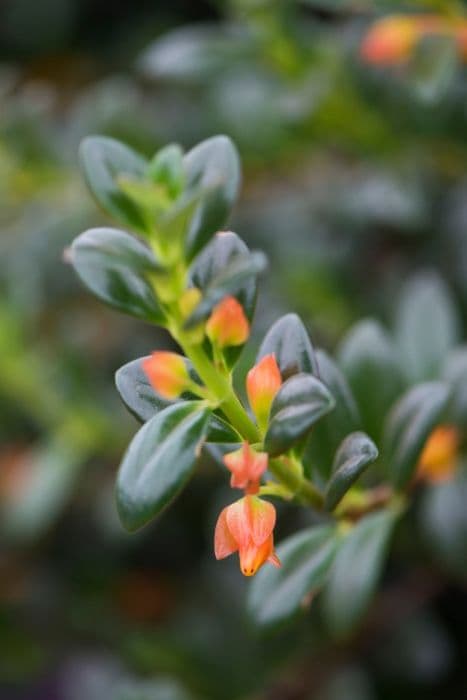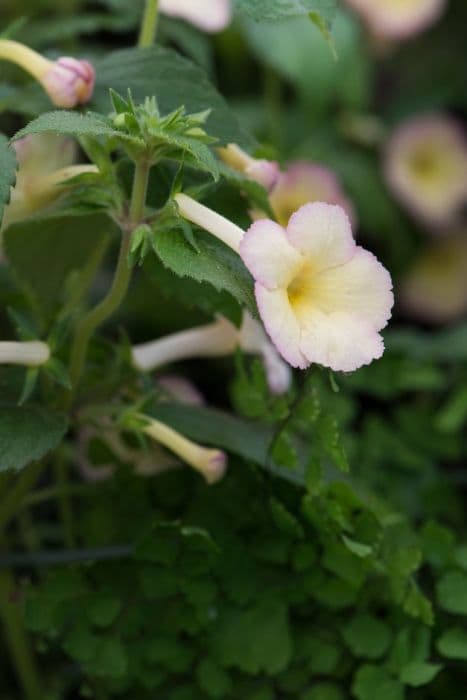Cape Primrose Streptocarpus 'Ruby'

ABOUT
Streptocarpus 'Ruby' is a striking flowering plant known for its lavish blossoms and lush foliage. The plant typically produces long, slender leaves that are velvety to the touch, forming a dense rosette. These leaves are a deep green, which serves as a perfect backdrop for the vibrant flowers. The blooms on the Streptocarpus 'Ruby' are characterized by their rich, ruby-red color, often showcasing a velvety texture and a trumpet-like shape. The flowers emerge from slender stems that rise above the foliage, making them quite eye-catching. The throat of the flower often displays a lighter shade or may have delicate streaks, adding to the visual interest of each bloom. The contrast between the intense red petals and the lush green foliage creates a dynamic and attractive display. The overall appearance of Streptocarpus 'Ruby' is one of abundance and vivid color, making it a popular choice for indoor gardens and displays.
About this plant
 Names
NamesFamily
Gesneriaceae
Synonyms
Cape Primrose, African Violet Cousin, Nodding Violet, Twisted Capsules
Common names
Streptocarpus 'Ruby'
 Toxicity
ToxicityTo humans
Cape primroses, including the Streptocarpus 'Ruby', are generally considered non-toxic to humans. There are no significant symptoms of poisoning associated with this plant, as it is not known to contain toxic substances that would cause harm if ingested in small quantities. However, eating any non-food plant can potentially cause some gastrointestinal discomfort, such as nausea or diarrhea, due to the presence of plant compounds that may irritate the digestive system.
To pets
Cape primroses are also generally regarded as non-toxic to pets. If a pet ingests part of a Cape primrose plant, it is unlikely to experience significant symptoms of poisoning. As with humans, the ingestion of plant material may cause mild gastrointestinal upset in some pets, but there is no specific toxicity associated with these plants that would warrant serious concern for pet owners.
 Characteristics
CharacteristicsLife cycle
Perennials
Foliage type
Evergreen
Color of leaves
Green
Flower color
Ruby
Height
1 foot (30 centimeters)
Spread
1 foot (30 centimeters)
Plant type
Herb
Hardiness zones
10
Native area
Africa
Benefits
 General Benefits
General Benefits- Aesthetic Appeal: Adds vibrant color and visual interest to indoor spaces with its striking ruby-red flowers.
- Low Maintenance: Requires minimal care, making it ideal for busy individuals or those new to gardening.
- Long Blooming Period: Often blooms for extended periods, providing color and beauty to a room for much of the year.
- Compact Size: With its small stature, it is well-suited for windowsills and limited space areas.
- Emotional Wellbeing: Presence of flowering plants like the African violet can enhance mood and promote a sense of well-being.
- Hobby Interest: Popular among houseplant enthusiasts, offering an enjoyable hobby in plant care and propagation.
 Medical Properties
Medical PropertiesThis plant is not used for medical purposes.
 Air-purifying Qualities
Air-purifying QualitiesThis plant is not specifically known for air purifying qualities.
 Other Uses
Other Uses- Illustration Subject: Streptocarpus 'Ruby', also known as Cape primrose, can be used as a subject for botanical illustrations and watercolor paintings, providing artists with vibrant colors to work with.
- Photography Prop: The striking appearance of Cape primrose can serve as an excellent photography prop, especially for macro photography that focuses on the details of its flowers.
- Teaching Tool: Educators might use Cape primrose to teach students about hybridization, flower structure, or plant care in biology classes.
- Gift Plant: The attractive blossoms of Cape primrose make it a popular gift plant for occasions like Mother's Day, birthdays, or as a housewarming present.
- Fairy Gardens: Due to its smaller size, Cape primrose can be a charming addition to indoor fairy gardens, adding a pop of color with its flowers.
- Color Therapy: The Ruby variety's rich hues can be used in color therapy sessions to invoke feelings of warmth and stimulation, enhancing the therapy experience.
- Hobby Breeding: Enthusiasts can use Cape primrose in amateur breeding programs to try and create new hybrids with unique colors and patterns.
- Stamp Design Inspiration: Postage stamp designers might incorporate the image of Cape primrose into their work, celebrating the beauty of flora and possibly raising botanical awareness.
- Crafting: Pressed flowers of Cape primrose can be used in crafting, such as in making handmade greeting cards, bookmarks, or in decoupage projects.
- Specialized Nurseries: Streptocarpus 'Ruby' can be a key attraction for specialized plant nurseries focusing on rare or exotic plants, drawing in plant collectors and enthusiasts.
Interesting Facts
 Feng Shui
Feng ShuiThe Cape Primrose is not used in Feng Shui practice.
 Zodiac Sign Compitability
Zodiac Sign CompitabilityThe Cape Primrose is not used in astrology practice.
 Plant Symbolism
Plant Symbolism- Resilience: Streptocarpus, also known as the Cape Primrose, often symbolizes resilience due to its ability to thrive under a range of indoor conditions and bounce back from neglect.
- Longevity: The long-lasting blooms of the Cape Primrose can be seen as a symbol of endurance and lasting beauty or emotion.
- Versatility: Its adaptability to various environments reflects versatility, making it a symbol for being able to thrive in different life circumstances.
- Hope: The bright and colorful flowers can represent hope, especially as they can bloom in less lit conditions, bringing brightness to darker spaces.
 Water
WaterFor Streptocarpus 'Ruby', also known as Cape Primrose, it is essential to maintain moist soil without letting the plant sit in water. Water the plant thoroughly when the top inch of the soil feels dry to the touch, approximately once a week, but adjust the schedule according to the humidity and temperature of your environment. Use room temperature water to avoid shocking the plant's roots. An average-sized pot may require around 8 ounces of water each time, ensuring the entire root ball is moistened. It is crucial not to leave excess water in the saucer, as Cape Primrose does not like "wet feet".
 Light
LightCape Primrose flourishes in bright, indirect light away from the harsh rays of direct sunlight. The ideal spot for a Streptocarpus 'Ruby' would be near a north or east-facing window where it can receive plenty of light without being exposed to the intense afternoon sun. If placed in too much shade, the plant may not bloom as vigorously.
 Temperature
TemperatureCape Primrose performs best in temperatures between 60 and 75 degrees Fahrenheit. It can tolerate a minimum temperature of 50 degrees Fahrenheit but should not be subjected to temperatures lower than this. Protecting the plant from drafts and sudden temperature changes will help maintain its health and encourage flowering.
 Pruning
PruningPrune Cape Primrose to remove spent flowers and yellowing leaves, encouraging a bushier growth and more blooms. Regular deadheading of old blooms enhances the plant's appearance and promotes further flowering. The best time for major pruning is in early spring or after the plant has finished a major flowering cycle.
 Cleaning
CleaningAs needed
 Soil
SoilThe best soil mix for Cape Primrose (Streptocarpus 'Ruby') is a well-draining, loamy or peaty substrate with added perlite or vermiculite for aeration. Aim for a soil pH between 5.5 and 6.5.
 Repotting
RepottingCape Primrose should be repotted every year or when it outgrows its pot, typically in late winter or spring before the onset of the growing season.
 Humidity & Misting
Humidity & MistingCape Primrose thrives in moderate to high humidity levels, ideally between 50% and 70%.
 Suitable locations
Suitable locationsIndoor
Place in bright, indirect light with high humidity.
Outdoor
Use dappled shade, shelter from rain and high humidity.
Hardiness zone
10-11 USDA.
 Life cycle
Life cycleThe life of a Cape Primrose starts with seed germination, where the tiny seeds, when provided with the right conditions of warmth and moisture, will sprout and begin to grow. The seedlings develop true leaves and, as they mature, they exhibit a rosette form with long, hairy leaves. As the plant grows, it develops a flowering stem with buds that bloom into the characteristic vivid flowers, often in shades of purple, pink, or blue, with the 'Ruby' variety typically presenting rich, ruby-colored blooms. After pollination, the flowers will fade and the plant will produce seed capsules that, when mature, can be harvested for propagation. The Cape Primrose has a perennial life cycle indoors or in favorable climates, and it can live for several years if it is properly cared for, with periods of active growth and flowering followed by dormancy. To maintain vitality, old leaves should be removed, and the plant may be periodically divided or propagated through leaf cuttings to rejuvenate and create new stock.
 Propogation
PropogationPropogation time
Spring to Summer
Propogation: The most popular method of propagating Streptocarpus 'Ruby', commonly known as Cape Primrose, is leaf cuttings. This is typically done in spring or early summer when the plant's growth is most vigorous. To propagate by a leaf cutting, a healthy leaf with a petiole is selected and cleanly cut from the plant with a sharp knife. The leaf is then laid flat and slightly pressed into a moist, well-draining potting mix. The leaf may be cut into wedges with a vein in each piece to produce multiple plants. The potting mix around the cutting should be kept damp but not waterlogged, and the container is often covered with plastic to maintain humidity. Roots and new plantlets usually develop at the base of the petiole or along the veins in a few weeks, at which point they can be gently separated and potted individually.









